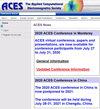Ultra-wideband Transmissive Linear Polarization Device Based on Graphene
IF 0.6
4区 计算机科学
Q4 ENGINEERING, ELECTRICAL & ELECTRONIC
Applied Computational Electromagnetics Society Journal
Pub Date : 2021-01-01
DOI:10.47037/2021.aces.j.360714
引用次数: 2
Abstract
In order to achieve both adjustable wideband and high Polarization Conversion Rate (PCR) of the transmitted waves, a novelty tri-layered structure is proposed for terahertz applications. The Rhombus Hollow Square (RHS) is built up by top and bottom gold gratings on Silicon Dioxide and Polyamide substrate with graphene strips. The proposed polarizer broadens the bandwidth and has well performance. As chemical potential increases, the bandwidth is also broadened by adjusting the graphene. From 0.5 THz to 3 THz, the PCR is greater than 90%, and the relative bandwidth up to 142.9%. The transmission and absorption of polarizer are analyzed at the oblique incidence with chemical potential 0.1eV. By simulating and analyzing the performance, a new result of maintaining broadband and high transmittance in oblique incidence is obtained.基于石墨烯的超宽带透射线性偏振器件
为了实现传输波的可调宽带和高偏振转换率,提出了一种新型的三层结构用于太赫兹应用。Rhombus Hollow Square (RHS)是由二氧化硅和聚酰胺衬底上的顶部和底部金光栅与石墨烯条构成的。该偏振器拓宽了带宽,具有良好的性能。随着化学势的增加,通过调整石墨烯,带宽也会变宽。在0.5 ~ 3thz范围内,聚合酶链反应大于90%,相对带宽达142.9%。分析了偏振片在化学势为0.1eV的斜入射下的透射和吸收特性。通过仿真分析,得到了在斜入射下保持宽带和高透射率的新结果。
本文章由计算机程序翻译,如有差异,请以英文原文为准。
求助全文
约1分钟内获得全文
求助全文
来源期刊
CiteScore
1.60
自引率
28.60%
发文量
75
审稿时长
9 months
期刊介绍:
The ACES Journal is devoted to the exchange of information in computational electromagnetics, to the advancement of the state of the art, and to the promotion of related technical activities. A primary objective of the information exchange is the elimination of the need to "re-invent the wheel" to solve a previously solved computational problem in electrical engineering, physics, or related fields of study.
The ACES Journal welcomes original, previously unpublished papers, relating to applied computational electromagnetics. All papers are refereed.
A unique feature of ACES Journal is the publication of unsuccessful efforts in applied computational electromagnetics. Publication of such material provides a means to discuss problem areas in electromagnetic modeling. Manuscripts representing an unsuccessful application or negative result in computational electromagnetics is considered for publication only if a reasonable expectation of success (and a reasonable effort) are reflected.
The technical activities promoted by this publication include code validation, performance analysis, and input/output standardization; code or technique optimization and error minimization; innovations in solution technique or in data input/output; identification of new applications for electromagnetics modeling codes and techniques; integration of computational electromagnetics techniques with new computer architectures; and correlation of computational parameters with physical mechanisms.

 求助内容:
求助内容: 应助结果提醒方式:
应助结果提醒方式:


